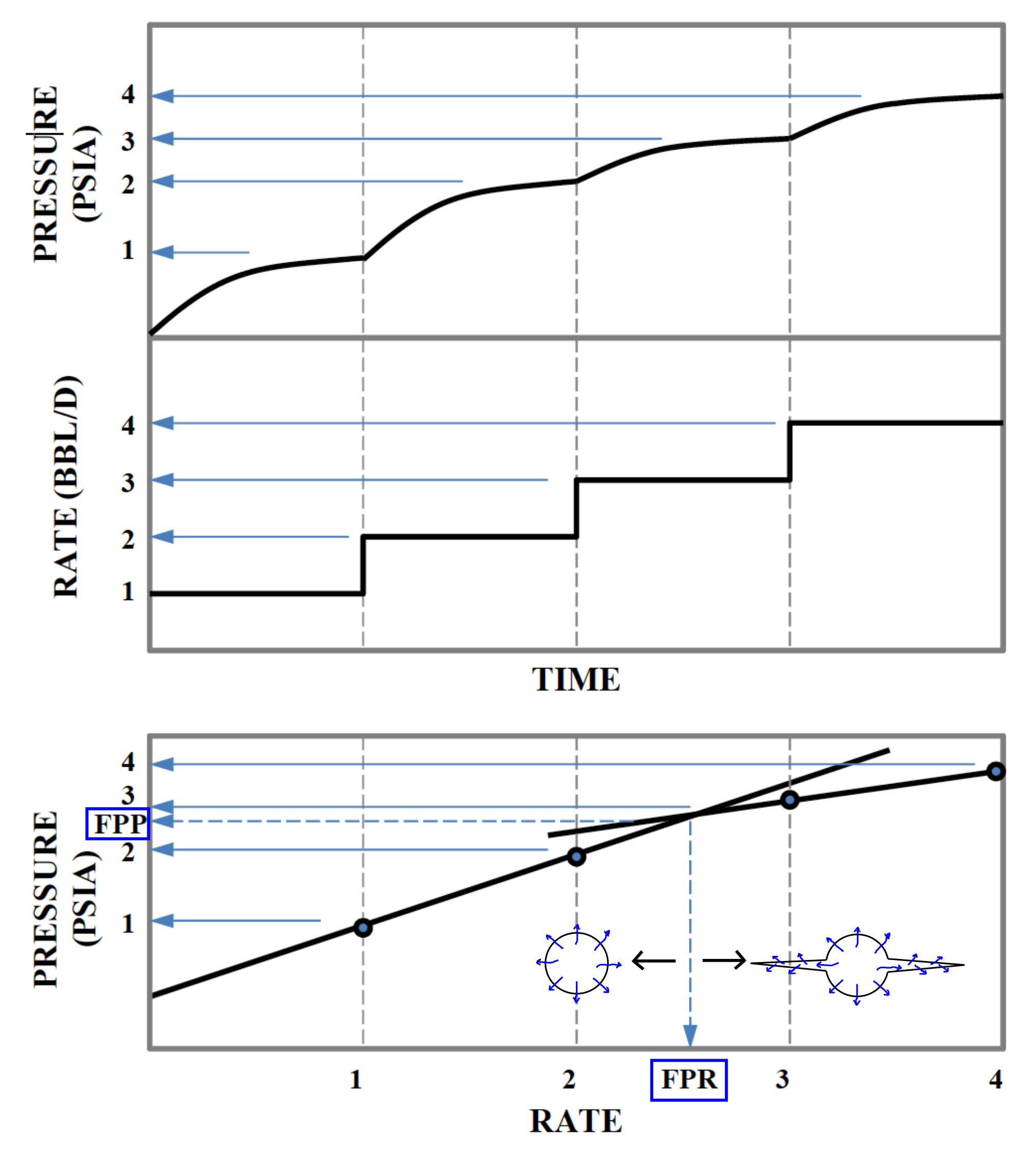Next: 7.3 Hydraulic fracture design: Up: 7. Hydraulic fracturing Previous: 7.1 Fluid-driven fractures in Contents
Understanding of hydraulic fractures is important for several applications in petroleum and geosystems engineering, from drilling and completion to enhanced oil recovery. The following field tests involve hydraulic fracturing and are suitable for specific applications.
The leak-off test is conducted to measure the fracture gradient required for setting maximum mud pressure for drilling. The test is conducted with drilling mud after cementing the casing of the previous section in an open-hole.
Execution of the leak-off test involves the following events:
 ). A change of slope may occur before FBP indicating a change of cavity volume, known as leak-off point (LOP).
). A change of slope may occur before FBP indicating a change of cavity volume, known as leak-off point (LOP).
Figure 7.3 shows an example of a leak-off test using another notation for the leak-off point and breakdown pressure. Some studies suggest that a deviation from linearity at the beggining of the test indicates the opening of a small fracture (FIP) until it reaches a maximum pressure (UFP) after which it propagates at a rate faster than the injected fluid. An “extended” leak-off test requires to reach the UFP (or FPP) pressure. Sometimes the leak-off tests may be stopped before UFP to avoid large fractures in the well.
![\includegraphics[scale=0.65]{.././Figures/split/9A-12.pdf}](img1045.svg) |
The shut-in pressure is the maximum pressure before the pressure signature exhibits a gradual decay as a function of time due to shutting the pumps.
While the fracture is still open in an uncased borehole, fluids in the fracture leak off from both the wellbore and the fracture.
Large leak-off surface (fracture walls and well) causes a rapid pressure decrease approximately proportional to the





![\includegraphics[scale=1.00]{.././Figures/split/9-MiniFrac_FCP.pdf}](img1048.svg) |
The objectives of the DFIT test are to determine permeability, determine pore pressure, and determine minimum principal stress 


![\includegraphics[scale=0.65]{.././Figures/split/9A-16.pdf}](img1050.svg) |
The mechanics of the DFIT test is similar to the one of the leak-off test. The determination of FCP is similar to that of the leak-off test. More advanced methods use a “G-function” to determine FCP. The G-function is a dimensionless time function designed to linearize the pressure signal during normal fluid leak-off from a bi-wing fracture.
![\includegraphics[scale=0.65]{.././Figures/split/9A-18.pdf}](img1051.svg) |
The step rate test helps determine the maximum injection pressure in a wellbore designed for constant and long-term injection.
Examples of injected fluids include water (liquid or vapor), CO

The Procedure of the step-rate test is the following (See Figure 7.8):
 5md and 15-30 min if k
5md and 15-30 min if k 10 md
10 md
 for each step as a function of injection rate
for each step as a function of injection rate 
 vs.
vs. 
 |
Each injection step is performed until the pressure signal approaches an asymptotic response (top and middle figures). This maximum pressure 






 |
(7.1) |
Figure 7.9 shows an example of a step rate test conducted with steam. The step-rate test is required test by some regulatory agencies in order to safely dispose produced water. The objective is to avoid fracturing of the injector. There are ongoing efforts to regulate injection of large volumes that may not fracture the injector but could reactivate neighboring faults.
![\includegraphics[scale=0.75]{.././Figures/split/9-SRTexample.pdf}](img1057.svg) |
Unintentional fracturing of the injector can be detrimental to sweep efficiency in EOR and IOR processes if the fracture connects the injectors and producers. On the other hand, fractures can be beneficial for sweep efficiency if oriented perpendicular to the direction of sweep (Fig. 7.10).
![\includegraphics[scale=0.55]{.././Figures/split/9-FracturesEOR.pdf}](img1058.svg) |